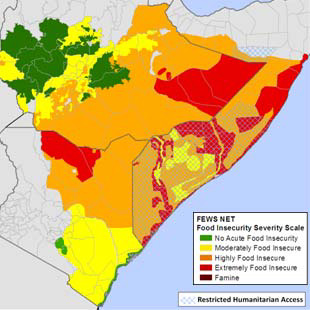Dr. Chris Funk, a researcher in the Climate Hazard Group of UCSB’s Department of Geography who is affiliated with the U.S. Geological Survey, explains how his group last year forecast the drought in Somalia that is now turning into famine — and how that warning wasn’t enough. The following was posted on the Nature website on August 3 and was summarized by the New York Times the same day:
Not since a million people died in Ethiopia and Sudan in 1984 and 1985 has the world seen such a potential for famine as it does now, with food emergencies occurring in Somalia, Ethiopia and Kenya. But although the ongoing disaster in East Africa is dire, it was not unexpected. In fact, I am part of a group of scientists that successfully forecast the droughts behind the present crisis. I work with the Famine Early Warning Systems Network (FEWS NET), which was set up by the US Agency for International Development to help policy-makers prevent such humanitarian disasters. The network identifies where food aid is needed by the most food-insecure populations of the developing world, whose livelihoods are tied to rain-fed subsistence agriculture and pastoralism.
Last summer, our group was meeting when a La Niña weather system was forecast. We knew that such an event could bring trouble, and we issued an alert that East Africa might experience severe droughts. We based this conclusion on information from three sources. First, we knew that La Niña events are commonly associated with weakened rains in the Horn of Africa from October to December. Second, from work on the ground, we knew that persistent poor rains at the end of the past decade, combined with high food prices, had weakened the population’s resilience to food emergencies. And third, research has linked warming in the Indian Ocean as a result of climate change to drying of March-to-June rains in East Africa. This warming has intensified the negative impact of La Niña events; it was the chance that both the autumn and spring rainy seasons could be affected, back to back, that really concerned us.
Sure enough, the autumn 2010 rains were poor, or failed completely. The outlook for famine or survival then rested on the spring rains. April came without rain. May came without rain. And we feared the worst. The situation on the ground quickly deteriorated. FEWS NET runs a food-price tracking system that showed that the price of maize (corn) in Kitui, Kenya, had soared by 246% in 12 months. And the value of a goat in Bardera, Somalia, usually sold to buy grain, had halved. Satellite measurements of vegetation health tracked the emerging drought in disturbing detail. FEWS NET put out a second alert on 7 June that warned: “This is the most severe food security emergency in the world today, and the current humanitarian response is inadequate.” Two months on, the grim statistics show that the massive crisis is outstripping the international resources available to address it. Famine conditions are expected to spread farther across Somalia, and large areas of Kenya and Ethiopia could see food availability fall to crisis levels. In all, some 11.5 million people across East Africa need emergency assistance.
So what went wrong? Why weren’t the warnings — before and during the drought — enough to avert a food crisis that might turn into famine? Much of the problem is tied to political issues, especially in Somalia, but there are also strong climate and agricultural components.
The global climate models used by the Intergovernmental Panel on Climate Change were never intended to provide rainfall trend projections for every region. These models say that East Africa will become wetter, yet observations show substantial declines in spring rainfall in recent years. Despite this, several agencies are building long-term plans on the basis of the forecast of wetter conditions. This could lead to agricultural development and expansion in areas that will become drier. More climate science based on regional observations could be helpful in addressing these challenges.
On the agricultural side, crop yields are very low, and not increasing much. The amount of farmland per person is decreasing rapidly, as population growth places more pressure on a limited landscape. Agricultural progress is not keeping pace with population growth. Declines in agricultural capacity are exacerbated by warming of the Indian Ocean, which is reducing the onshore flow of moisture during the spring rainy season, creating more frequent droughts. These trends are having an impact in southern Ethiopia, central and eastern Kenya and southern Somalia — those regions that have been hardest hit this year. Warmer and drier weather is shrinking the amount of land that is suitable for farming, leaving burgeoning food-insecure populations exposed to more frequent and severe climate shocks.
Emergencies such as the one in East Africa will become more common unless there is a focus on improving agricultural production. Ironically, the fact that crop yields are low creates a tremendous opportunity for improvement. A 50%, or even 100%, increase in yields is feasible, and would greatly improve the availability of food. Better integrated markets and increased grain and water storage can help to keep resources on hand for lean times. In the long term, a more resilient system is needed, rather than an increase in the number of emergency grain shipments. Then, when disaster strikes, surplus food can be moved around the region — from Tanzania to Somalia, say. Better regional climate-change and forecast models, combined with more effective agriculture in drought-threatened areas will not solve all problems, but they should reduce the need for emergency responses, and make such measures more effective when they are necessary.
Editors note: This is one of several articles relating to Dr. Funk’s research on this subject. Others include Research by Funk and Williams Links Indian Ocean Warming with East African Drought, Current Climate Trend Analysis of Kenya by Chris Funk, Chris Funk Uses Satellite Imagery to Forecast African Drought, and Why Space Matters, Time and Time Again.

.jpg)
.jpg)


.svg.png)
